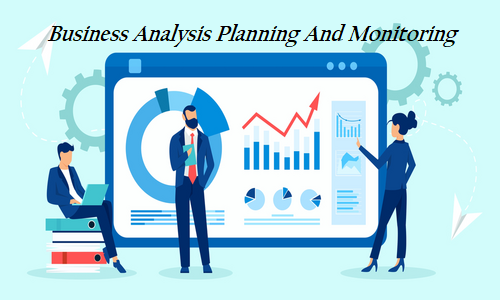A business analyst contributes to a project’s life cycle by performing a prior business evaluation that serves as a guide. The planning and completion of business analysis are based on a procedure called Business Analysis Planning and Monitoring. It is also the foremost of the knowledge areas in BA.
The planning and monitoring part employs the fundamental principles of BACCM (BA Core Concept Model). These concepts help in approaching the satisfaction of organizational needs in the right way. The responsibility of assessing stakeholders’ requirements lies with a business analyst. It is a prerequisite of appropriate monitoring and planning. Performance analysis is also included in this phase since it is the means of adding value to an enterprise’s business.

Steps To BA Planning And Monitoring
The tasks listed here emphasize role defining, approaches to different project areas, and coordination between stakeholders and analysts.
Approach to business analysis
The planning of how to address business analysis is a task in itself. It is the stage of deciding on methods of business analysis execution. This task involves the basic preparation of activities related to every other BA knowledge area. Project deliverables and timelines are the outputs of this stage. Business analysts create a structured framework of approaches and procedures to standardize their performance. This calls for their cooperation with project stakeholders. An organization’s opportunities, problems, and needs are considered inputs for drafting the mode of business analysis. Keeping in mind that business needs may change with the project’s course, a business analyst would frame the plan accordingly.
Stakeholder engagement
As mentioned earlier, the collaboration of stakeholders and business analysts plays a pivotal role. The stakeholder engagement phase is crucial to make this joint effort successful and maintain it, as well. Business analysts must be adept at identifying stakeholders’ requirements alongside understanding the latter’s relevance. This is possible only through effective communication with stakeholders. Before that, a business analyst must thoroughly study the traits of every prominent stakeholder of the project.
The complexity of this task increases with the number of stakeholders involved in the project. An existing approach undergoes adjustment each time the project includes a new stakeholder. The organizational need is the input for this planning phase, as well. Proper knowledge of what an enterprise requires helps in properly identifying the chief stakeholders. Besides, the selection of appropriate business analysis methods is also responsible for ensuring better communication between stakeholders and business analysts. Information on the characteristics and assignments of every stakeholder, along with their total count, is derived at this stage. A business analyst considers the following factors while arranging for stakeholder management:
- Description of the current state
- Strategy for bringing changes
- Evaluation of the performed business analysis task
Project sponsors, managers, suppliers, regulators, end-users, and domain experts come within the list of a project’s prime stakeholders. To sum up, the responsibilities of a business analyst in organizing stakeholder management are as follows:
- Meet the requirements of interacting with stakeholders
- Establish collaboration with stakeholders
- Identify the potential, decision-making authority, role, and attitude of different stakeholders in a project.
Business analysis governance
This stage is about identifying the components that will assist in an organization’s governance. Proper planning for making business decisions is essential. This covers all business aspects, including prioritization, reviews, requirements, changes, and designs. The smooth sailing of an enterprise depends on a straightforward governance process. This calls for spotting decision-makers with the right competencies. The availability of precisely defined information is also necessary for decision-making. Both the stakeholder engagement and business analysis approaches appear significant during this phase. The results of those two tasks serve as primary inputs for planning the governance of business analysis. This governance approach selects and mentions the details of stakeholders who will possess the authority of decision-making. The core components of the governance plan are:
- Approval planning
- Prioritization approach
- Control process change
- Decision-making
Regulatory information, business policies, information on the current state of business operations, and the assessment of business analysis execution. These are the tools used in governance planning. The list of stakeholders for this phase remains the same as that of the previous one.
Information management
The task of planning information management involves the sorting out of methods for collecting information. It includes the ways of accessing, storing, and integrating the information generated from business analysis with the available information. This results in the acquisition of an enormous amount of data that demands proper handling for future usage. The planning phase is significant for the optimization of the gathered information so that it can be accessed whenever required. Apart from tools related to information management, the other guidelines of execution remain the same as in the previous stages. Project sponsors, regulators, and domain experts are counted as leading stakeholders for this purpose. The core areas of concentration are:
- Information storage and accessibility
- Organization of the collected information
- Plan the traceability approach
- Requirement reuse planning
- Determine the abstraction level and requirements attributes
Identify performance improvements
The ultimate task in the planning and monitoring of business analysis is to identify its benefits. To find out whether the business analysis performance is fructifying is essential for tapping every possible opportunity for improvement. This stage is centered around the implementation of corrections wherever required. It involves the evaluation of a business analyst’s performance. An organization’s extreme goals and the determined business analysis method are the main inputs of the performance management stage. The output of this phase is a comparison between the details of both the planned and performed business analysis activities. Identification of serious issues and finding effective solutions to them form the core of business analysis performance improvement.
Courses regarding PMI-PBA Training encourage individuals to become knowledgeable in the varying aspects of business analysis. This knowledge area of BA is crucial for mastering the skills to become an ace in this domain.



